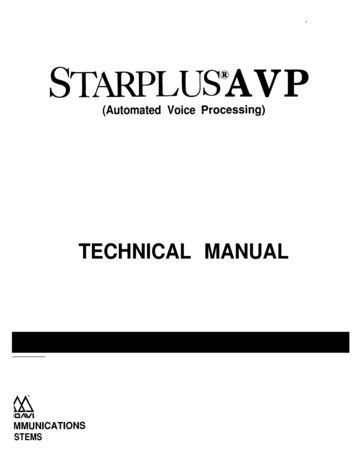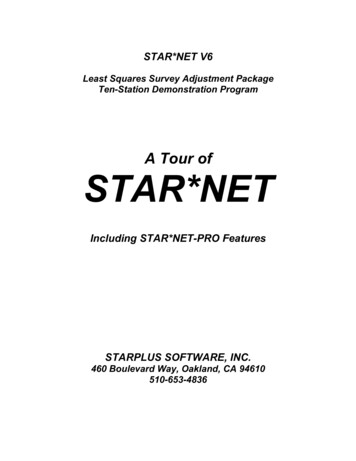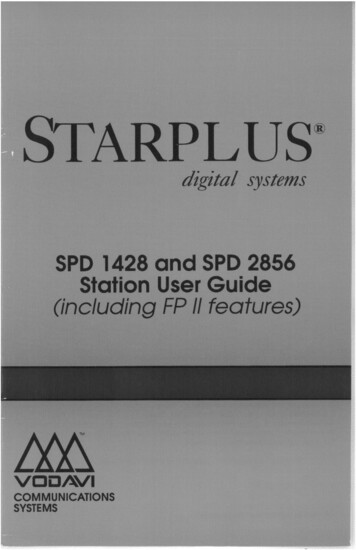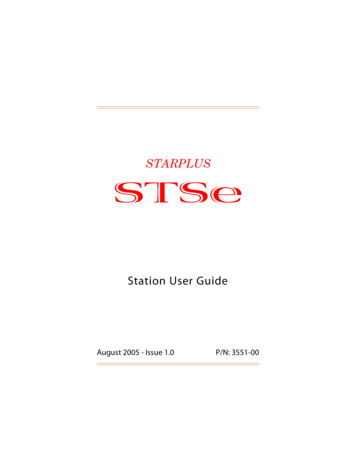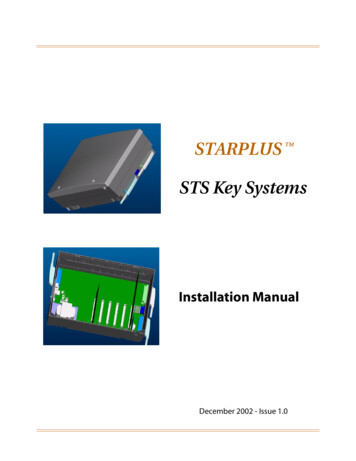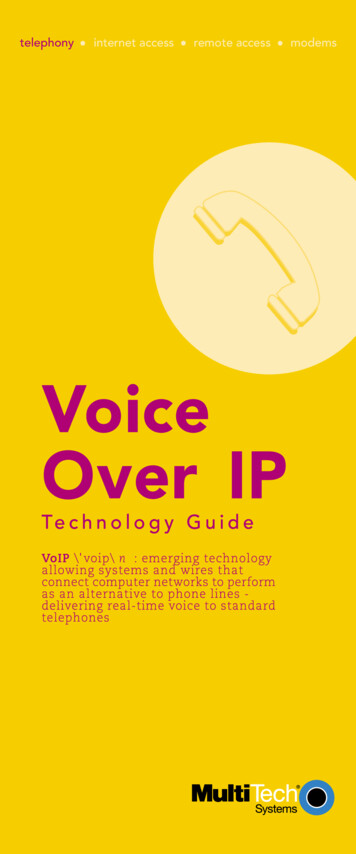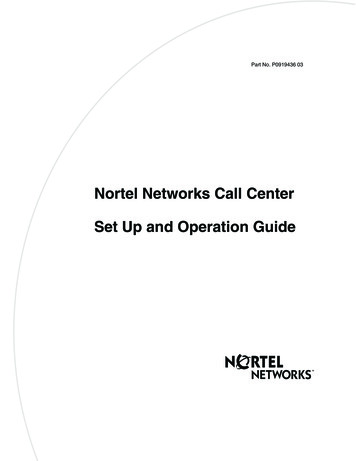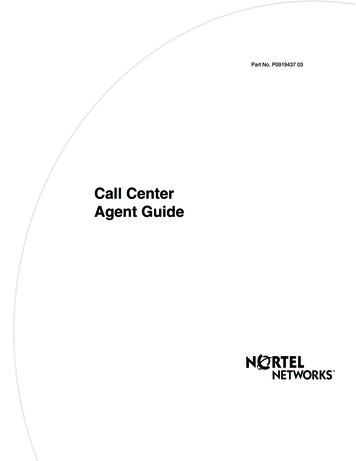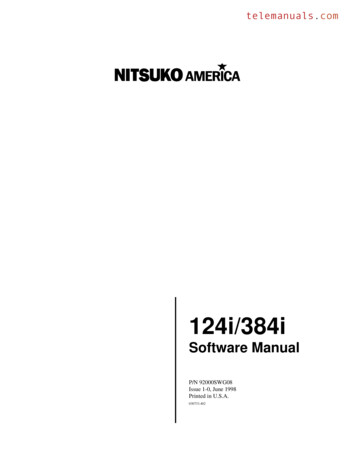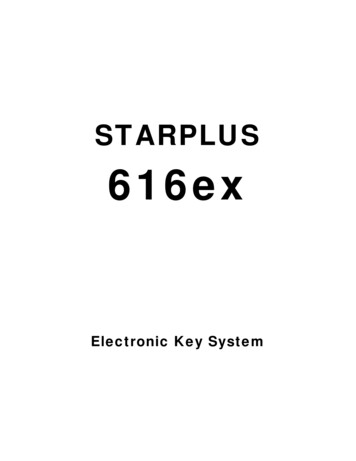
Transcription
STARPLUS616exElectronic Key System
ISSUE 2 JULY I,1987STARPLUS 616EXTABLE OF CONTENTSSECTION 100100.1100.2SECTION 200200.1200.2200.3200.4SECTION 300300.1SECTION 18PAGEINTRODUCTIONPURPOSE.l-lREGULATORY INFORMATION (FCC). . . . . . . . . l-lGENERAL DESCRIPTIONTECHNOLOGY.2CAPAClTY.2SYSTEM COMPONENTS.SYSTEM SPECIFICATIONS.12.2-2.2-3FEATURE DESCRIPTIONALPHABETICALLISTING OF FEATURES. . .3-2INSTALLATIONSITE PLANNING .UNPACKING THE 616EX KSU .KSU GROUNDlNG.4KSU INSTALLATION .KSU CABLING .LIGHTNING PROTECTION.KEY TELEPHONE INSTALLATION .WALL MOUNT KIT INSTALLATIONPHONE BOX INSTALLATION.EXTERNAL MUSIC SOURCE .ALARM INSTALLATION .BAlTERY BACK-UP. .EXTERNAL PAGING. .LOUD BELL CONTROL. .EMERGENCY TRANSFER.HEADSET INSTALLATION.MINI PRINTER INSTALLATION.INSTALLATION AND POWER-UP 4-74-74-74-74-84-8
ISSUE 2 JULY I,1987STARPLUS 6’16EXSECTION 500.27500.28500.29500.30500.31500.32500.33SECTION 600600.1600.2600.3600.4CUSTOMER DATA BASE PROGRAMMINGINTRODUCTION .CUSTOMER DATA WORKSHEET.DATA BASE FIELDS. .PROGRAM MODE ENTRY .SYSTEM INITIALIZATION. .STATION CLASS OF SERVICE. .STATION DATA .STA ASSIGNMENTS.CO LINE ACCESS. .PAGINGGROUP.CO LINE GROUPS. .CO LINE PROGRAMMING.CO LINE RINGING- DAY .CO LINE RINGING - NIGHT .FLASH TIMER .CO RING DETECT. .DIAL PULSE. .SYSTEM CONFIGURATION.SYSTEM TIMERS. .EXECUTIVE/SECRETARYASSIGNMENTS.LOUD BELL CONTROL. .PBX DIALING CODES .ATTENDANT POSITION .CALL FORWARD PRESET .CONFERENCE TIMER .SMDR.SMDRiBAUD RATE .DATA BASE PRINTOUT. .TOLL RESTRICTION TABLES .STATION SPEED DIAL. .DIAL PULSE TO TONE SWITCHOVER.FLASH WITH SPEED DIAL .NIGHT SERVICE 75-75-85-85-85-85-105-l 15-l 25-l 25-l 25- 125-l 35-l 35-135-l 45-l 45-l 75-l 85-l 85-l 85-l 8TEST PROCEDURESPRELIMINARY CHECKLIST.KEY STATION TESTING .INTERCOM FUNCTIONS TEST .CO LINE FUNCTIONS TEST. .II6-l6-l6-36-5
ISSUE 2 JULY 1,1987STARPLUS 616EXSECTION 0.10700.11700.12700.13700.14MAINTENANCEAND TROUBLE SHOOTINGGENERAL INFORMATION.INTRODUCTION.PREVENTIVE MAINTENANCE.TEST EQUIPMENT AND TOOLS .SPARE PARTS .FIELD SERVICE ENGINEERING.TROUBLE SHOOTING PROCEDURES .FAULT CLASSIFICATION.SYSTEM FAILURE. .POWER FAILURES .KEY TELEPHONE FAILURES .CO/PBX LINE FAILURES. .FEATURE OPERATION FAILURES .SUMMARY OF FAULT CONDITIONS. . . . .7-l. 7-l. 7-1. 7-1. 7-1. 7-l.7-l7-l7-2. 7-2. 7-2. 7-2. 7-27-4INDEX OF FIGURESPAGEFIGURE 1.1FIGURE 1.2FIGURE E2.22.34.14.24.34.45.17.1.STARPLUS KEY TELEPHONE.STARPLUS KEY TELEPHONE.STARPLUS 616 SYSTEM.WITH ALL EXTERNAL CONNECTIONSKEY SERVICE UNIT-LEFT SIDE .KEY SERVICE UNIT-RIGHT SIDE .TYPE 630 WALL MOUNT JACK. .PROCESSOR OR POWER FAILURE TRANSFER.EXTERNAL CONNECTIONS.RS- 232C CONNECTIONS.TOLL RESTRICTION FLOW CHART. .STARPLUS SYSTEM BLOCK DIAGRAM . . l-2. . 1-3. . . 2-7. . 2-8. . 2-9. 4-l 1. . 4-12’ 4-13.4-8. .5-19. . 7-3
ISSUE 2 JULY I,1987STARPLUS 616EXINDEX OF TABLETABLE3-l4-14-24-35-15-25-35-45-57-lFEATURE INDEX. .GEL-TYPE BAlTERY AMP. HOUR REQUIREMENTS.J-l CONNECTING BLOCK LAYOUT .J-2 CONNECTING BLOCK LAYOUT .DATA FIELDS AND DEFAULT VALUES .ACCESS AND RINGING - DAY. .ACCESS AND RINGING - NIGHT. .NUMBERING PLAN .DATA BASE PRINTOUT. .POWER TEST. .IV.: .3-l4-6.4-94-10.5-3.5-9.5-9.5-l 85-l 5.7-l 4
ISSUE 2 JULY I,1987STARPLUS 616EX616 EX ISWE CONTROLISSUECHANGEDATE1 MAR 87First draft.1 MAY 87Addition of backgroundchange in programming1 JUL87music to programming,of message wait reminderISSUE 2 - Add BBU installation,mini-printertone,installation.
STARPLUS 616EX100ISSUE 2 JULY I,1987INTRODUCTION100.1. PURPOSEC. CHANGES IN SERVICEThis manual provides the information necessary toprogram, install, operate and maintain theSTARPLUS 6 16EX Key Telephone System.100.2REGULATORYINFORMATIONThe local telephone company may make changesin its communications facilities or procedures.If these changes should affect the use of the616EX or compatibility with the network, thethe telephone company must give written noticeto the user to allow uninterrupted service.(FCC)The Federal Communications Commission (FCC)has established rules which allow the directconnection of the STARPLUS 616EX Key TelephoneSystem to the telephone network. Certain actionsmust be undertaken or understood before theconnection of customer provided equipment iscompleted.D. MAINTENANCE LIMITATIONSMaintenance on the 616EX Key TelephoneSystem is to be performed only by themanufacturer or its authorized agent. The user maymay not make any changes and/or repairs exceptas specifically noted in this manual.If unauthorized alterations or repairs areperformed, any remaining warranty may bevoided.A. TELCO NOTIFICATIONBefore connecting the STARPLUS 616EX KeyTelephone System to the telephone network,the local serving telephone company must begiven advance notice of intention to usecustomer provided equipment (CPE) andprovided with the following information:E. NOTICE OF COMPLIANCEThe 616EX Key Telephone complies with rulesregarding radiation and radio frequency emissionby Class A computing devices. In accordancewith FCC Standard 15 (Subpart J) the followinginformation must be supplied to the end user:1. The telephone numbers to be connectedto the system.“WARNINGThis equipment generates and uses R.F. energy,and if not installed and used in accordance withthe Instruction Manual, it may cause interferenceto radio communications. It has been tested andfound to comply with the limits for a Class Acomputing device, pursuant to Subpart J ofPart 15 of the FCC Rules, which are designedto provide reasonable protection against suchinterference, when operated in a commercialenvironment. Operation of this equipment in aresidential area is likely to cause interference,in which case the user, at his own expense,will be required to take whatever measuresmay be required to correct the interference.”2. The FCC Registration Number located on theKey Service Unit (KSU). DLP82V-72088-KF-E3. The Ringer Equivalence Number also locatedon the Key Service Unit (KSU). 0.2A4. The USOC jack required for directinterconnection with the telephone network.RJl lCB. INCIDENCE OF HARMIf the telephone company determines that thecustomer provided equipment (CPE) is faulty andpossibly causing harm or interruption to thetelephone network, it should be disconnecteduntil repair can be effected. If this is not done,the telephone company may temporarilydisconnect service.F. HEARING AID COMPATIBILITYThe 616EX Key Telephone is Hearing AidCompatible, as defined in Section 68.316 ofPart 68 FCC Rules.l-l
ISSUE 2 JULY I,1987STARPLUS 616EXBASIC MODELENHANCEDSTARPLUS KEY TELEPHONEFIGURE 1.1l-2
ISSUE 2 JULY I,1987STARPLUS 616EXEXECUTIVE MODEb‘STARPLUS KEY TELEPHONEFIGURE 1.2l-3
ISSUE 2 JULY 1, 1987STARPLUS 616EX200200.1GENERAL DESCRIPTIONTECHNOLOGYThe system power is regulated by a switching powersupply. This technology provides high efficiency withlow heat. A shielded transformer converts the1 17 VAC into logic voltages on a separate powersupply PCB, mounted within the KSU cabinet.Each key telephone contains a microprocessorandcircuitry to monitor button activity and control lamp(LED) indications. A built in speaker permits voice ortone calling to the station. Executive andEnhanced model telephones have a Busy LampField (BLF) to monitor station activity in the system.The STARPLUS 616EX Key Telephone System is amicroprocessorcontrolled, solid state electronicswitch which distributes communicationsin anon-blockingformat. All control, switching andinter-face circuitry is condensed onto a single printedcircuit board (PCB) located inside the key serviceunit (KSU).Switching is accomplishedthrough a solid statecrosspoint matrix that provides voice pathconnecticnsfor six (6) central office lines, sixteen(16) key te!ephones and eight (8) intercomchannels.Basic, Enhanced and Executive model keytelephone sets are all equipped with eight (8)function buttons and six (6) CO line buttons.In addition Enhanced and Executive modelphones are equipped with sixteen (16) Direct StationSelection (DSS) buttons and the Executive telephoneis equipped with an LCD as standard equipment.A three-position slide switch is provided for easyselection of INTERCOM signaling modes, along withseparate tone ringing and voice volume controls.The central microprocessoris a Z-80 and controlsthe crosspoints and central office line relays.It also controls communicationsoetween slavemicroprocessorslocated in each key telephone.The 616EX KSU contains all system memory whichis composed of 16K of Read Only Memory (ROM)and 4K of Random Access Memory (RAM).The RAM is subdivided so that 2K is used 2.s CPUworking area and 2K is used for customer data baseThe customer data base memory is protected fromloss by a long life lithium battery. A Program Modulecontains the operating instructions for the system.This module can be easily removed and replacedwhich allows for upgrading software features.For emergency applications, a stand-alone batteryassembly may be connected to the battery chargingoutput terminals on the 6! 6EX KSU. This retainssystem power in the event of commercial powerfailure.The system offers automatic cut-thru of central officelines to optionally provided single line telephones.These instruments can make and receive calls duringa commercial AC power outage or following aCPU failure.2-l
ISSUE 2 JULY 1,1987STARPLUS 616EX200.2CAPACITY616EX ENHANCEDKSUUses Program Module II which provides StationMessage Detail Recording and a Real Clock Unit.SMDR allows a customer to track incoming and/oroutgoing, local and/or long distance calls by CO line,number dialed, time of day and date, station thatplaced the call, duration of the call and an accountcode. The Real Clock Unit provides Executivetelephones with LCD to have time and date displayedand the time clock functioning in case of commercialpower failure.The 616EX Key Service Unit (KSU) is housed in awall mountable cabinet that contains the Key ServiceBoard (KSB), power supply and pre-wiredconnectors for station and CO line interface.The system comes fully configured for 6 CO lines,16 key telephones and 8 intercom channels.One external page port provides two-way externalpaging capability. One loud bell control port offersprogrammable external signaling. One Music-OnHold input allows connection of an external musicsource for MOH and background music.Separate MOH and background music adjustmentsare provided on the KSU. One alarm input allowsconnection of an external alarm or other sensingdevice. Low cost phone boxes may be substitutedfor key telephones on a one-for-one basis.BASIC MODEL KEY TELEPHONEIs a fully modular, multi-line keyset with voice andtone ringing volume controls. Contains 6 centraloffice line buttons, 8 functions buttons, a dial padand an intercom mode selection switch. All buttonsare of the non locking type with easy to see LED’sThe sjlstem contains the necessary interfacecircuitry to enable complete system battery backupoperation. In the event of commercial AC powerinterruption, a 24 volt DC battery assembly providedby the customer will ensure uninterruptedsystemoperation. The battery support units must beprovided separately.for quick identification.ENHANCED MODEL KEY TELEPHONEIdentical to the Basic Key Telephone with theaddition of 16 Direct Station Select buttons and aspeakerphoneto provide full handsfree operation.EXECUTIVE MODEL KEY TELEPHONE200.3Identical to the Enhanced Key Telephone with theaddition of an interactive LED display.Displayed features include calls to and from otherextensions, number dialed, line used, camp-on, etc.SYSTEM COMPONENTSThe following are the components that make up the616EX key telephone system:The Basic KSU or the Enhanced KSUThe Key Telephone(Basic, Enhanced or Executive)Wall Mount KitProgram Module (I or II)Phone Box616EX BASICWALL MOUNTKITProvides an attractive modular means of attachingthe StarPlus key telephone to any vertical surface.PHONE BOXAllows handsfree conversations to and from locationsthat do not need dialing privileges. Phone boxes maybe substituted for key stations on a one-for-onebasis.KSUThe KSU is a sealed, self contained unit that has nouser-serviceableparts inside. All connectionsaremade externally through amphenol-typeplugs andscrew terminal connections.A Program Module (I)allows easy expansion of software features.PROGRAM MODULE IThis plug in unit provides the instructions to thesystem giving feature and operating data.PROGRAMMODULE IIProvides basic system operating instructionsaddition provides for Station Message DetailRecording and a Real Clock Unit.2-2and in
ISSUE 2 JULY 1,1987STARPLUS 616EX200.4SYSTEM SPECIFICATIONSSIGNALING SPECIFICATIONSVISUAL INDICATIONSVISUALINDICATIONSOff Hook’Busy (All Stations)Incoming Intercom (Destination)Call Announce (Destination)Message Wait Callback (Destination)Do Not Disturb (All Stations)Door Box Calling (All Stations)Steady120 ipm120 ipm120 ipmSteady30 ipmflutterflutterflutterflashCO LINE BUTTONSIncoming CO RingTransferred CO RingRecallQueued LineExclusive HoldSystem HoldI-Hold (Only when hold preferenceIn UseFUNCTIONis system)lBothThe* BothThelflashflashflutterflutterflashwinkdouble flashBUTTONSCall Forward (Active)* *Message Waiting (Active)Camp On (Active)Line Queue (Active)Do Not Disturb (Active)ON/OFF (Speakerphoneon/on-hookConference(Active)Hold (All intercom paths busy)l30 ipm120 ipm480 ipm480 ipm120 ipm60 ipm30 ipmSteadydialing)call forward and DND status are indicated by one LED.call forward will be shown when both features have been employed.Message Wait and Camp On are indicated by one LED.camp on indication will take priority when both features are active.2-315 ipm double flash15 ipm flash60 ipm flashSteadySteadySteadySteadySteady
ISSUE 2 JULY 1, 1987STARPLUS 616EXAUDIBLE SIGNALSNAMETONE (Hertz)DURATION (Seconds)Incoming CO LineIntercom Tone Ringing121514711215/1471Intercom Call AnnounceTransferred CO LineLine RecallMessage Wait Callback9351215114711215i1471121511471.5 oni2.5 off: R.5 on.5 offi.5 on/l .5 off; R.2 on’.2 off; 3 bursts.5 on’2.5 off: R.5 oni2.5 off; R.5 oni.5 off, .5 on/1.5 off; R.5 on; timed perprogramming.l on/.5 off; R.2 or-V.2 off; once1 sec. burstMessage Waiting Reminder ToneQueued CallbackCamp-OnPaging Alert ToneAlarm ToneRepeatedSingleLoud Bell ControlCO Ringing & Transferred CO LinesIntercom RingingPhone BoxBusy ToneError ToneIntercom Dial ToneDND TonePaging ConfirmationConference Time Out Warning ToneProgramming Confirmation ToneProgramming Error Tone771I1215/14711215/147193570118577011857701 /a57701701701701935701147114712-4.25 on/.25 off; R1 .O sec. on; once.5 closed/2.5 open; R.5 closed/.5 open/.5 closed/l .5 open; R1 .O sec. on; once.5 on/.5 off; R.25 on/.25 off; RContinuous.25 on/.25 off; R 3 times/pause; R1 sec. burst.02 or-V.02 off; 3 bursts1.5 sec. burst.25 on/.25 off; R 6 times
ISSUE 2 JULY 1,1987STARPLUS 616EXELECTRICALAC Input to PS-,,,,,,,,u,.Power ConsumptionOutput VoltageStation Cable Lengths(Twisted,(Maximum)800 ft. of 26 AWG Cable1200 ft. of 24 AWG Cable1500 ft. of 22 AWG Cablepair cable)Fuse - AC Input24 V 0.7 A. 250 V0.7 A. 250 VMusic Source2 K Ohms(Input)Contact RatingExternal Page ControlLoud Bell Control Alarm1 .O A, 24 VDC1 .O A, 24 VDCExternal Page PortOutput ImpedanceOutput Power600 Ohms @ 0 dBm5 mW MaximumENVIRONMENTALOperatingOptimumHumidity--/70 WATTS28 VDC, 0.5 ABattery Input Connectort60 HzTemperature32to122F60 to 80 F5% to 95% (non condensing)2-5I/1
ISSUE 2 JULY I,1987STARPLUS 616EXDIALINGDTMF DIALINGFrequency DeviationRise TimeDuration of DTMF SignalInterdigit Time or - 1.5 Hz5 msec.70 msec. minimum130 msec. minimumPULSE DIALINGPulse Dialing Rate (programmable)Percent BreakMake(Programmable)10to20pps60140 to 66133DIALING MEMORY40 numbers (16 digit) any assigned station10 numbers (16 digit) per key telephone1 number (32 digit) per key telephoneSystem Speed DialingStation Speed DialingLast Number RedialLoop StartCO TypeDIMENSIONS AND WEIGHTKEY SERVICEUNIT22 inches14 inches2.5 inches14 Ibs.HeightWidthDepthWeightKEY esinchesIbs.BOX1.75 inches5.5 inches4 inches1 lb.HeightWidthDepthWeight2-6
ISSUE 2 JULY 1,1987STARPLUS 616EXx--LLl (I) m‘DE III Z.ZIZ- Z lllllllllll III IllllllII lllllll-ag2v)2-7
ISSUE 2 JULY I,1987STARPLUS 616EXMDF CON-PROGRAM616EXPEXTERNALBATERY BACK-UPCONNECTOR0 OIllLOWER MOUNTlNGBRACKETSKEY SERVICE UNIT-LEFTFIGURE 2.22-8SIDEMODULE
ISSUE 2 JULY I,1987STARPLUS 616EXUppER MOUNTINGBRACKETSlllllI llllllll11111111lllllllllllllRJI 1CCONNECTORSFOR CO LINECONNECTIONS//RS 232C PORTFUSE,GROUNDKEY SERVICE UNIT - RIGHT SIDEFIGURE 2.32-9LUG
ISSUE 2 JULY 1, 1987STARPLUS 616EXTABLE 3-lFEATURE INDEXFeatureAvailabilityAlarm SignallingAll Call Voice PagingAttendant PositionAutomatic HoldAutomatic PrivacyAutomatic Pause InserttonBackgroundMusicBattery Back-Up (Memory)Battery Back-Up (System)Call ForwardingCall Pick-UpCall TransferCall WaitingCO Line GroupingCO Ring AssignmentsCO Line QueuingConferenceDial Pulse. DTMF SrgnallingDirect Station SelectDisplay TelephoneDSS CO Automatic Line SelectDo Not DrsturbEmergencyTransferExclusive HoldExecutiveSecretaryTransferExternal PagingFlashFlexible DSS AssignmentHold PreferenceIntercom Signalling ModeInternal Zone Paginglast Number RedialLoud Bell ControlMeet Me PageMessage WaitingMusic on HoldNight ServiceOn-Hook DialingPBX Dialing CodesPhone BoxPreferred Line AnswerPrivate LinePulse to Tone SwitchoverSMDRSpeakerphoneSystem HoldSystem Speed DialStation Speed DialToll RestrictionToll Restriction OverrideWall TelephoneS - standardN - noneNNNNNNNNNNNNNNNNNNNPM IINNNNNNNNNNNNNNNNNNNNNNNPM II, SSSSSSSSS0SSS00SSSSS00 mentRequiredAlarm SystemNNNNNMusic SourceNBattery Pkg.NNNNNNKSUNNNNExecutive PhoneNNSLT’sNNPaging Equip.NNNNNNExt. Bell/Ring Gen.NNMusic SourceNNNPhone BoxNNNPrinterNNNNNNN
ISSUE 2 JULY I,1987STARPLUS 616EX300FEATURE DESCRIPTION300.1ALARMALPHABETICALLISTING OF FEATURESBATTERYSIGNALINGThe system can recognize either an open or closedloop from an external relay and transmit an alarmsignal. This signal can be sent to all available(non-busy) stations with either a continuous or singletone. The type of alarm tone is selected in systemprogramming.BATTERYBACK-UP (SYSTEM)Optional maintenance free battenes and cabling canbe directI\, connected to the STARPLUS 616EX KSUto provide full system operation in the event of acommercial power outage. Calls in progress willcontinue without interruption when the power fails.The batteries are recharged with an external batterycharger when the system returns to normal ACoperation.ALL CALL VOICE PAGINGAllowed stations may make voice pagingannouncementsto all idle stations, phone boxes andexternal paging ports of the same time. Paging is aprogrammable feature and is assigned per station.ATTENDANTBACK-UP (MEMORY)A long life lithium battery is provided in the KSU toretain the system data base in the event of a po’weroutage or the system power being turned off.CALLINGPOSITIONSTATIONINDICATOR(BUSY Lamp Field)Enhanced and Executive model key telephonesare equipped with an LED indicator under eachDirect Station Selection (DSS) button to indicate thestatus of the other keysets in the system.The system allows a.ny key telephone station to beassigned as the system attendant. The assigneds)lstem attendant WIII receive unattended line recallsand will initiate NIGt-lT SERVICE.CALL ANNOUNCINGAUTOMATIC HOLDA slide switch on the telephone allows users toselect the way that calls to their phone arevoice announced.Pressing a STATION or CONF key while on anoutside line will automatically place the CO (outside)line on hold. This allows quick internal consultationand call transfer.CALL FORWARDING-PRESETSystem programming allows incoming CO lines, thatare programmed to ring a particular station, to beforwarded to another predeterminedstation.This occurs when the station normally receiving theCO ring is busy or does not answer the call.AUTOMATIC PRIVACYPrivacy is automatically provided on allcommunicationsin the system. If desired, the systemmay be programmed to eliminate privacy, allowingany station to join in on existing CO lineconversations.CALL PICKUPStations can begroups. Stationsringing intercomCO line calls forAUTOMATIC PAUSE INSERTIONIf a flash is programmed into system and stationspeed dial numbers and save redial numbers,a pause will automatically be inserted after the flash.A pause will also be automatically inserted after aPBX dialing code has been used.placed in one or both of 2 pickupwithin a group can pick up tonecalls and recalling or transferredanother station in that group.CALL FORWARDING-STATIONEach key telephone user may direct intercom callsand transferred CO lines to be forwarded to anotherstation in the system. A forwarded call will signalin the TONE mode regardless of the way theintercom signaling switch was set.BACKGROUND MUSICKey telephones may receive music over theirspeaker when a music source has been connectedto the system. The music can be turned on or offand the volume adjusted at each individual station.Maximum loudness level can be adjusted on the616EX KSU.3-2
ISSUE 2 JULY I,1987STARPLUS 616EXCALL TRANSFERCO LINE QUEUINGAn outside CO line can be transferred from onekeyset to another. By pressing the STATION buttonof the desired party, or pressing TRANS buttonand then dialing that station number. unscreenedtransfers or screened transfers with anannouncementcan be made. The line beingtransferred rungs on the keyset and gives a ftashindication to the receiving party’s keyset. Severalattempts can be made to find someone at differentkeysets without losing the call. If a line is transferredto a busy station, it will receive muted ringing.When CO lines are busy, stations can be placed ona list awaiting that CO line or a CO line in the sameline group to become available. When a CO linebecomes available, the system signals the waitingstation. If the waiting station is busy when thequeued CO line becomes available, the staton isplaced at the bottom of the queue list.Three attempts will be made to reach a busy stationbefore that station is dropped from the queue list.If a station doesn’t answer the que signal in 6 rings,that station will be dropped from the queue list.CAMPCONFERENCEON (CALLWAITING)A station may alert a busy party that an outsideline is on hold and waiting for them by use of theCall Waiting feature. To Camp-On a call, transferthe call to the desired busy station, then press theMSG CP.ON button twice. The called station willreceive muted ring, hold flash indication on thewaiting line. and a flashing “HOLD” button if thecamp-on initiator is waiting to talk. The busy partycan press the MSGICP.ON button, automaticallyplacing his outside line on hold, to confer with thecamp-on initiator. A station may camp-on anotherbusy station without having a CO line connection,if desired. A CO line camped-on a station will recallthe camp-on initiator if not picked up after theprogrammable period of time expires. Only theattendant station can camp-on to a station in the DNDmode with a visual indication only. A camp-on cannotbe made to a station in conference.The stationdesignated “EXECUTIVE”in an ExecutiveSecretarypair can be camped-on only by the correspondingsecretary.A)Multi-LineOne (I ) internal station can engage in aconference with two (2) external parties.An external party can be dropped from theconference by pressing the CO line button of theparty wishing to remain. The internal station mayplace the conferenceon HOLD by pressing the“HOLD” button.‘3Add-on ConferenceTwo (2) internal stations can engage inconference with one (1) external party or 3internal parties can set up a conferences.There is no limit on the number of add-onconferences,except for the total number ofCO lines connected to the system.COMMONAUDIBLERINGING (LOUD BELL)Incoming CO line ringing of a station can be directedto Loud Bell Control contacts. There is one (1) setof dry contacts that may be assigned to a station.An external power source and ringing device isrequired.CO LINE GROUPINGCO lines can be in one of up to six (6) groupsto separate line types such as local, FX, PBX, etc.Stations are then individually assigned access tothese lines and given the ability to dial on particularlines.DIAL PULSElDTMF SIGNALINGI.Each outside line can be individuallyprovide dial pulse or tone sending.programmedDIAL PULSE TO TONE SWITCHOVERto-The signalling on a CO line can be changed from dialpulse to tone (DTMF). This allows dial pulsetelephones to use common carriers which requireDTMF signalling. This feature can also be storedand used with speed dial numbers.CO RING ASSIGNMENTSCO lines are assigned to ring on a per-station basisaccording to system programming. Any station maybe programmed to ring for any line(s) in the Dayand/or during Night service.3-3
ISSUE 2 JULY 1, 1987STARPLUS 616EXDIRECT STATIONSELECTIONEXTERNALSixteen (16) buttons are dedicated at eachExecutive and Enhanced Key Telephone forimmediate signalling and connection to other stations.DSSlCOAUTOMATICAny station except one assigned as COS 6 canmake voice paging announcementsto the externalpaging port. Two way talkback paging is also possibleLINE SELECTFLASHA DSS or CO line can be selected by pressing theassociated button and automatically place the phonein the dialing mode. CO lines will bring up dial toneand DSS stations are automatically signalled.The Flash button is used to re-establishtransfer a PBX call.FLEXIBLEPlacing a keyset in DND will eliminate incomingCO line ringing, intercom calls, CO line transfers,All Call Page announcementsand Camp-Ons.The attendant position can override a station in DND,except for “executive”designated stations.The corresponding“secretary” can override the“executive”DND using the Camp-On feature.The station in DND can use the telephone to makenormal outgoing calls. By programming, a stationcan be denied this feature.This allows either exclusive hold or system hold tobe the primary hold on the first depression of thehold button.INCOMINGHOLDTone Ringer (T)A standard tone ring notifies the party of anincoming call. The party answers by lifting thehandset.2)Page (P)The station user receives a short tone burst anda voice announcementover the speaker.The microphone is deactivated, providingprivacy. The person who is called must lift thehandset to get the call or switch the selector tohandsfree.3)Handsfree (H)The station user, upon hearing a short tone burstand voice announcementover the integratedspeaker, can reply handsfree.(Basic model key telephones do not havethis feature.)TRANSFERFour (4) pairs of key telephones can be designatedas executive/secretary.Whenever the “executive”phone is in D
STARPLUS 616EX ISSUE 2 JULY 1, 1987 200 GENERAL DESCRIPTION 200.1 TECHNOLOGY The STARPLUS 616EX Key Telephone System is a microprocessor controlled, solid state electronic switch which distributes communications in a non-blocking format. All control, switching and inter-face circuitry is condensed onto a single printed
